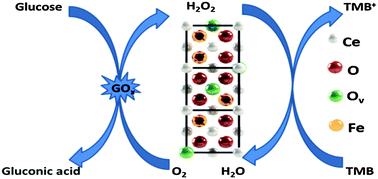Fe-doped CeO2 nanorods for enhanced peroxidase-like activity and their application towards glucose detection†
Abstract
The construction of highly efficient inorganic mimetic enzymes (nanozymes) is much needed to replace natural enzymes due to their instability and high cost. Recently, nanoscale CeO2 has been attracting significant interest due to its unique properties such as facile redox behaviour (Ce4+ ↔ Ce3+) and surface defects. In the present work, various amounts of Fe3+-doped CeO2 nanorods (NRs) (with 3, 6, 9, and 12% Fe doping) were synthesized using a facile hydrothermal method and investigated for peroxidase-like activity and glucose detection. The peroxidase-like activity results revealed that 6 at% doping is the optimal Fe doping level to demonstrate superior catalytic performance over un-doped and Fe3+-doped CeO2 NRs. Steady state kinetic analysis also confirms that the 6% Fe3+-doped CeO2 (6Fe/CeO2) NRs exhibited excellent catalytic performance towards 3,3′,5,5′tetramethylbenzidine (TMB) oxidation with a Km and Vm of 0.176 mM and 8.6 × 10−8 M s−1, respectively, as compared to horseradish peroxidase (HRP) enzymes (0.434 mM and 10.0 × 10−8 M s−1). Typical colour reactions arising from the catalytic oxidation of the TMB substrate over 6Fe/CeO2 NRs with H2O2 have been utilized to establish a simple sensitive and selective colorimetric assay for the determination of glucose concentration in buffer, diluted fruit juices and foetal bovine serum samples. The superior catalytic performance of 6Fe/CeO2 NRs could be attributed to abundant surface defects, high surface area and pore volume, and preferential exposure of the highly reactive (110) planes.

- This article is part of the themed collection: JMC B Editor’s choice web collection: ‘‘seeing the unseen updated: advances in biosensing’’

 Please wait while we load your content...
Please wait while we load your content...